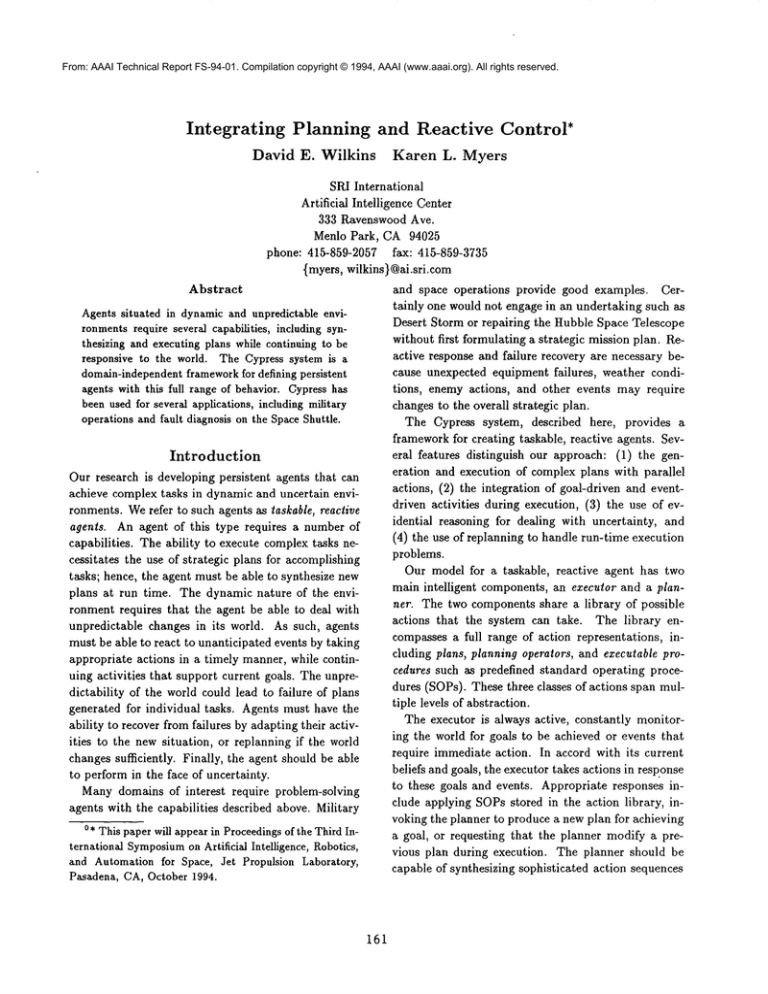
From: AAAI Technical Report FS-94-01. Compilation copyright © 1994, AAAI (www.aaai.org). All rights reserved.
Integrating
Planning and Reactive
David E. Wilkins
Control*
Karen L. Myers
SRI International
Artificial Intelligence Center
333 Ravenswood Ave.
Menlo Park, CA 94025
phone: 415-859-2057 fax: 415-859-3735
{myers, wilkins}@ai.sri.com
and space operations provide good examples. CerAbstract
tainly one would not engage in an undertaking such as
Agents situated in dynamicand unpredictableenviDesert Storm or repairing the Hubble Space Telescope
ronmentsrequire several capabilities, includingsynwithout first formulating a strategic mission plan. Rethesizing and executing plans while continuingto be
active response and failure recovery are necessary beresponsive to the world. The Cypress system is a
cause unexpected equipment failures, weather condidomain-independent
framework
for defining persistent
agents with this full range of behavior. Cypresshas
tions, enemy actions, and other events may require
beenused for several applications, includingmilitary
changes to the overall strategic plan.
operationsandfault diagnosis on the SpaceShuttle.
The Cypress system, described here, provides a
frameworkfor creating taskable, reactive agents. Several features distinguish our approach: (1) the genIntroduction
eration and execution of complex plans with parallel
Our research is developing persistent agents that can
actions, (2) the integration of goal-driven and eventachieve complex tasks in dynamic and uncertain envidriven activities during execution, (3) the use of evronments. Werefer to such agents as taskable, reactive
idential reasoning for dealing with uncertainty, and
agents. An agent of this type requires a number of
(4) the use of replanning to handle run-time execution
capabilities. The ability to execute complex tasks neproblems.
cessitates the use of strategic plans for accomplishing
Our model for a taskable, reactive agent has two
tasks; hence, the agent must be able to synthesize new
main
intelligent components, an executor and a planplans at run time. The dynamic nature of the enviner.
The two components share a library of possible
ronment requires that the agent be able to deal with
actions
that the system can take. The library enunpredictable changes in its world. As such, agents
compasses a full range of action representations, inmust be able to react to unanticipated events by taking
cluding plans, planning operators, and executable proappropriate actions in a timely manner, while contincedures such as predefined standard operating proceuing activities that support current goals. The unpredures (SOPs). These three classes of actions span muldictability of the world could lead to failure of plans
tiple levels of abstraction.
generated for individual tasks. Agents must have the
The executor is always active, constantly monitorability to recover from failures by adapting their activing
the world for goals to be achieved or events that
ities to the new situation, or replanning if the world
require immediate action. In accord with its current
changes sufficiently. Finally, the agent should be able
beliefs and goals, the executor takes actions in resp.onse
to perform in the face of uncertainty.
to these goals and events. Appropriate responses inManydomains of interest require problem-solving
clude applying SOPs stored in the action library, inagents with the capabilities described above. Military
voking the planner to produce a new plan for achieving
0. This paper will appear in Proceedingsof the Third Ina goal, or requesting that the planner modify a preternational Symposium
on Artificial Intelligence, Robotics,
vious plan during execution. The planner should be
and Automationfor Space, Jet Propulsion Laboratory,
capable of synthesizing sophisticated action sequences
Pasadena, CA, October 1994.
161
that include parallel actions, conditional actions, and
resource assignments. The planner plans only to a certain level of detail, with the executor taking that plan
and expanding it at run time by applying appropriate
library actions at lower levels of abstraction.
Cypress
Cypress constitutes a framework in which to define
taskable, reactive agents based on the above model.
The architecture of Cypress is depicted in Figure 1.
The motivation for Cypress was to build a heuristically adequate system for use in practical applications. To this end, Cypress relies on mature, powerful planning and execution technologies, namely the
SIPE-2 generative planner (Wilkins et al. to appear)
and the PrtS-CL reactive execution system (Wilkins et
al. to appear). Wehave applied Cypress to a number
of demanding problems, including real-time tracking,
fault diagnosis on the Space Shuttle, production-line
scheduling, and military operations (Wilkins et al. to
appear).
PRS-CLis a framework for constructing persistent,
real-time controllers that perform complex tasks in dynamic environments while responding in timely fashion
to unexpected events. It has been used to monitor the
Reaction Control System (RCS) of the Space Shuttle
(Wilkins et al. to appear). This application illustrates
the use of multiple agents, and has been used to detect
and recover from most of the possible malfunctions of
the RCS, including sensor faults, leaking components,
and regulator and jet failures.
The system demonstrated guaranteed response, support for asynchronous
inputs, interrupt handling, continuous operation, and
handling of noisy data.
SIPE-2 is a partial-order AI planning system that
supports planning at multiple levels of abstraction. It
has the properties required by our agent model, including the ability to generate plans that include parallel
actions, conditional actions, resource assignments, and
the ability to modify previously generated plans. In
contrast to most AI planning research, heuristic adequacy has been a primary design goal of SIPE-2.
PRS-CLand SIPE-2 employ their own internal representations for plans and actions for efficiency. For
this reason, Cypress supports the use of an interlingua called the ACTformalism (Wilkins et al. to appear) that enables these two systems to share information. ACTprovides a language for specifying actions
162
and plans for both planners and executors. Cypress
includes translators that can automatically map Acts
onto SIPE-2 and PRS-CLstructures, and one that can
map SIPE-2 operators and plans into Acts. Using the
ACTinterlingua, PRS-CLcan execute plans produced
by SIPE-2 and can invoke SIPE-2 in situations where
run-time replanning is required. The ACT-Editorsubsystem supports the graphical creation and display of
Acts. Gister-CL (Wilkins et al. to appear) implements
a suite of evidential reasoning techniques that can be
used to analyze uncertain information about the world
and possible actions. For example, Gister-CL can be
used to reason about uncertain information in order to
choose amongcandidate Acts in either the planner or
executor.
In contrast to manyother agent architectures, planning and execution operate asynchronously in Cypress,
in loosely coupled fashion. This approach makes it
possible for the two systems to run in parallel, even on
different machines, without interfering with the actions
of each other. In particular, PP~S-CLremains responsive to its environment during plan synthesis. While
the subsystems of Cypress can function independently,
Cypress is used most advantageously as an integrated
frameworkthat supports a wide range of planning and
executionactivities.
Applications
An example from military
operations
planning
(Wilkins &Desimone1994) is currently the only implementedapplication that illustrates the use of all subsystems of Cypress, but it is similar to a space mission.
The most advantageous use of Cypress in space applications will most likely be in situations that do not
directly involve humans. A planetary rover will certainly need the combination of plan-directed behavior
with reactive response to the environment provided by
Cypress, and can build directly on our use of Cypress
modules to control an indoor mobile robot. Other appropriate space applications include control of a satellite or probe, controlling experiments on the shuttle
or space station, and providing an assistant to astronauts to handle routine malfunctions and alert them of
important events that affect the overall mission plan.
The military application domain knowledgeincludes
approximately 100 plan operators, 500 objects with 15
to 20 properties per object, and 2200 initial predicate
instances. Plans range in size from several dozen to
ACT-Editor
/
ACT->Sipe,Sipe->ACT
translators
SIPE-2
PRS-CL
-common
interface
-generativeplanning
-customizegraphics
-reactiveexecution
-replanning
-replanningoverseer
replanning
operatorselection
objectselection
situationassessment
,,
Gister-CL
-reasoningaboutuncertainty
~|~lra:J~l lu r~ti:~ection
situation assessment
I
Figure 1: The Architecture o~’ Cypress
200 actions, including manythat are to be executed in
parallel (Wilkins & Desimone1994).
The scenario begins with a goal request for deterring several military threats. SIPE-2 uses a set of
Acts previously input to the system to generate a plan
with many threads of parallel activities.
During the
planning process, Gister-CL assists SIPE-2 in choosing appropriate military forces for particular missions,
by analyzing uncertain information about the situation. Throughout the planning process, PRS-CLmonitors the world for additional goals and events that
might require immediate action. PRS-CLexecutes the
plan by applying appropriate Acts to refine the plan to
lower levels of abstraction, eventually bottoming out in
actions that are executable in the world.
PRS-CLresponds to many unexpected events by applying Acts representing SOPs. Sometimes an event
causes an execution failure that cannot be repaired by
any defined Acts (e.g., if transit approval is rescinded
for air space that is being used). PR.S-CLthen invokes
a second PRS-CLagent to issue a replanning request
to SIPE-2. Meanwhile, the first agent continues exe-
163
cution of parallel threads of the plan not affected by
the failure. The planner modifies the plan by eliminating actions that use the air space in question and
replacing them with an alternative mobilization. The
actions in the new plan are selected so as not to interfere with the continuing execution of other actions in
the original plan. The new plan is sent to to the first
agent, which integrates the new plan with its current
activities and continues.
In a similar fashion, a Cypress agent controlling a
planetary rover would have the executor handle unexpected obstacles in its path, and call the planner to
modify the plan when progress can no longer be made
in the desired direction. On a satellite, the executor
could continue to monitor spacecraft systems while requesting the planner to modify the plan for transmitting pictures back to earth after a failure in one of the
transmitters.
Conclusion
References
Cypress is a powerful framework in which to define
agents that must accomplish complex goals in dynamic
and unpredictable environments. The application of
Cypress to the military domain and to the Space Shuttle’s RCS(only the PRS-CLsubsystem is used) attests
to the system’s usefulness.
The asynchronous replanning facility constitutes one
important technological advance, providing flexible
plan execution that can adapt to significant unexpected changes in the world. An interesting technical problem that had to be solved was the design of
ACTas a commonrepresentation
for both executors
and planners. PRS-CLhad to be extended in numerous ways to support the execution of plans employing
constructs not found in the domain procedures defined
for previous PRS-CLapplications.
Several characteristics
distinguish Cypress from
other systems that provide both planning and reactive execution. Many systems do not use generalpurpose planning and so cannot generate plans of sufficient complexity for interesting applications. Previous
work in run-time replanning has either been limited
to synchronous approaches (Laird 1990) or focuses
local, adaptive modifications to rule sets, rather than
employing the full look-ahead reasoning of a planner
(Lyons & Hendricks 1992; Firby 1987). The ability
modify a complex, parallel plan at run time and adapt
execution activity to the new plan is, to our knowledge,
a new accomplishment.
Firby, R. J. 1987. An investigation into reactive planning in complex domains. In Proceedings of the lg87
AAAI, 202-206.
Laird, J. 1990. Integrating planning and execution in
Soar. In Proceedings of the AAAI Spring Symposium.
Lyons, D. M., and Hendricks, A. J. 1992. A practical
approach to integrating reaction and deliberation. In
First International Conference on AI Planning Systems, 153-162.
Wilkins, D. E., and Desimone, R. V. 1994. Applying
an AI planner to military operations planning. In
Fox, M., and Zweben,M., eds., Intelligent Scheduling.
Morgan Kaufmann, San Mateo, CA. 685-709.
Wilkins, D. E.; Myers, K. L.; Lowrance, J. D.; and
Wesley, L. P. to appear. Planning and reacting in
uncertain and dynamic,environments. Journal of Experimental and Theoretical AL
Acknowledgments
This research
was supported
by the ARPA and
Rome Laboratory Planning Initiative
(ARPI) under Contract F30602-90-C-0086. The implementation
of the military operations domain was done under
ARPA/RomeLaboratory Contract F30602-90-C-0086
by Marie Bienkowski, Marie desJardins, and Roberto
Desimone. The RCS application
was supported by
NASAAmes Research Center and was done by a team
led by Michael Georgeff. SIPE-2, PRS-CL, Gister-CL,
Grasper-CL, and Cypress are trademarks of SRI International.
164




